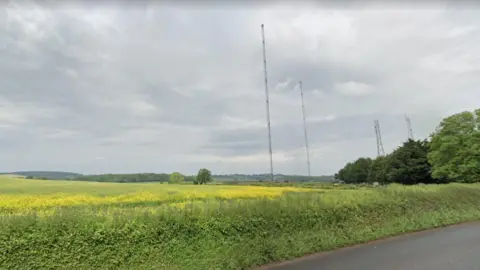Controversial solar farm given permission
 Google
GoogleA controversial solar farm will be built on a large piece of farm land following a successful appeal.
Elgin Energy applied in December 2021 to build a new solar farm north of Tropiquaria Zoo on the A39, near the village of Washford, on land owned by the Wyndham Estate.
Somerset Council’s planning committee west threw out the plans in July 2023, citing the damage to protected landscapes and the loss of high-quality agricultural land, with the planning inspectorate overturning the move.
The solar farm will span several fields north of the Washford transmitting station, running from the B3190 Washford Hill to the Mineral Line active travel route, which connects Washford to the nearby town of Watchet.
'Man-made features'
Elgin Energy (which first consulted on the proposals back in May 2018) said the solar farm would provide enough energy to provide power for 7,500 households.
A battery energy storage site will also be created near the site, allowing Elgin Energy to store surplus energy and sell it back to the National Grid at peak times.
In addition to opposition from local residents, the solar farm was also strongly criticised by CPRE Somerset, the Exmoor National Park and the Quantock Hills National Landscape organisation.
Councillors threw out plans last year, citing the damage to protected landscapes and the loss of high-quality agricultural land, the Local Democracy Reporting Service said.
Planning inspector Cullum Parker visited the site on 30 April and published his detailed ruling on 28 May.
Mr Parker said that neither the Exmoor National Park or the Quantock Hills National Landscape would “be adversely affected” by the solar farm, due to its distance from the boundaries of both protected areas.
He said concerns about the impact on the natural landscape were undermined by “man-made features” in the local area, including the radio transmission towers near Tropiquaria Zoo and the Hinkley Point C complex.
Mr Parker added the solar farm was sufficiently far from the main roads to not be overly visible to passing motorists, with the existing hedgerows along the A39 and the B3190 providing ample screening.
He also ruled there would be no adverse impact on the Mineral Line active travel route due to the high levels of vegetation screening the route from the solar farm site.
'No detailed analysis'
Reports commissioned by CPRE Somerset and the local tenant farmers stated the land was “some of the better quality arable land in this area of west Somerset.”
But Mr Parker was dismissive of these reports, arguing they “offered no detailed analysis” of the key issues and were “based on little more than a walk over of the fields and high-level maps from the 1980s”.
He added: “Soil samples from the site indicate that the site comprises entirely lower quality agricultural land’.
Mr Parker did agree with Historic England that the proposals would result in a “marked change” to the landscape and harm the setting of local heritage assets, such as the grade one listed St. Decuman’s Church in Watchet.
However, he decided this harm would be of “less than substantial in magnitude” and could be mitigated through high-quality landscaping.
Follow BBC Somerset on Facebook and X. Send your story ideas to us on email or via WhatsApp on 0800 313 4630.
